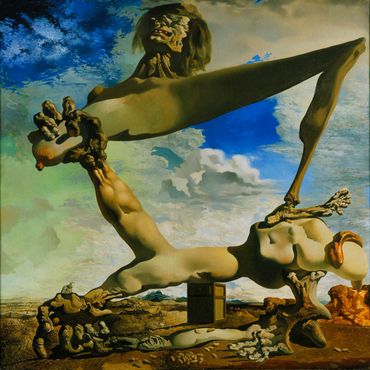Art Movement - Surrealism
Surrealism (1920s–1950s)
– Explored dreams, the unconscious mind, and irrational imagery; artists include Salvador Dalí and René Magritte.
The Surrealism Art Movement
Surrealism was a revolutionary cultural and artistic movement that emerged in the early 1920s in Europe, rooted in the aftermath of World War I and inspired by the writings of Sigmund Freud. Surrealist artists sought to unlock the power of the unconscious mind and tap into dreams, fantasies, and irrational thought. Rejecting logic, realism, and traditional artistic conventions, Surrealism emphasized the strange, the unexpected, and the symbolic. The movement’s goal was to challenge established norms and provoke new ways of thinking, blending the boundaries between reality and imagination.
Prominent figures in Surrealism included artists like Salvador Dalí, René Magritte, Max Ernst, and Joan Miró. Their works often featured bizarre juxtapositions, dreamlike landscapes, and fantastical imagery—such as melting clocks, floating objects, or distorted figures—that defied conventional interpretation. Surrealism was not limited to painting; it extended into literature, film, photography, and theater. André Breton, considered the founder of the movement, outlined its principles in the Surrealist Manifesto (1924), emphasizing "pure psychic automatism" as a method of accessing the subconscious. Surrealism had a lasting impact on modern art and culture, influencing everything from advertising and design to contemporary film and literature.
Salvador Dalí
Salvador Dalí (1904–1989)
was a Spanish surrealist artist known for his eccentric personality, technical mastery, and strikingly bizarre imagery. One of the most prominent and recognizable figures of the Surrealist movement, Dalí created art that explored dreams, the subconscious, time, memory, and identity. His most famous painting, The Persistence of Memory (1931), featuring melting clocks draped over a dreamlike landscape, has become an iconic symbol of Surrealism and is often interpreted as a meditation on the fluid nature of time.
Dalí’s work extended far beyond painting—he was also involved in sculpture, film, photography, fashion, and even product design. He collaborated with filmmakers like Luis Buñuel on experimental films such as Un Chien Andalou (1929), and his flamboyant public persona made him a celebrity in both the art world and popular culture. Dalí’s precise, classical technique combined with irrational subject matter created a unique and instantly recognizable style. Though often controversial for his eccentric behavior and political ambiguity, his imagination, ambition, and innovation left a profound mark on 20th-century art. He was a French painter and one of the founding figures of the Impressionist movement, a term that itself was derived from his 1872 painting Impression, Sunrise (Impression, Soleil Levant). Monet is best known for his focus on capturing the effects of light and atmosphere in natural settings, often painting the same scene at different times of day or in varying weather conditions. He used quick, visible brushstrokes and a bright color palette to portray his subjects with a sense of immediacy and movement, a radical departure from the detailed realism of earlier art styles.












This website uses cookies.
We use cookies to analyze website traffic and optimize your website experience. By accepting our use of cookies, your data will be aggregated with all other user data.


